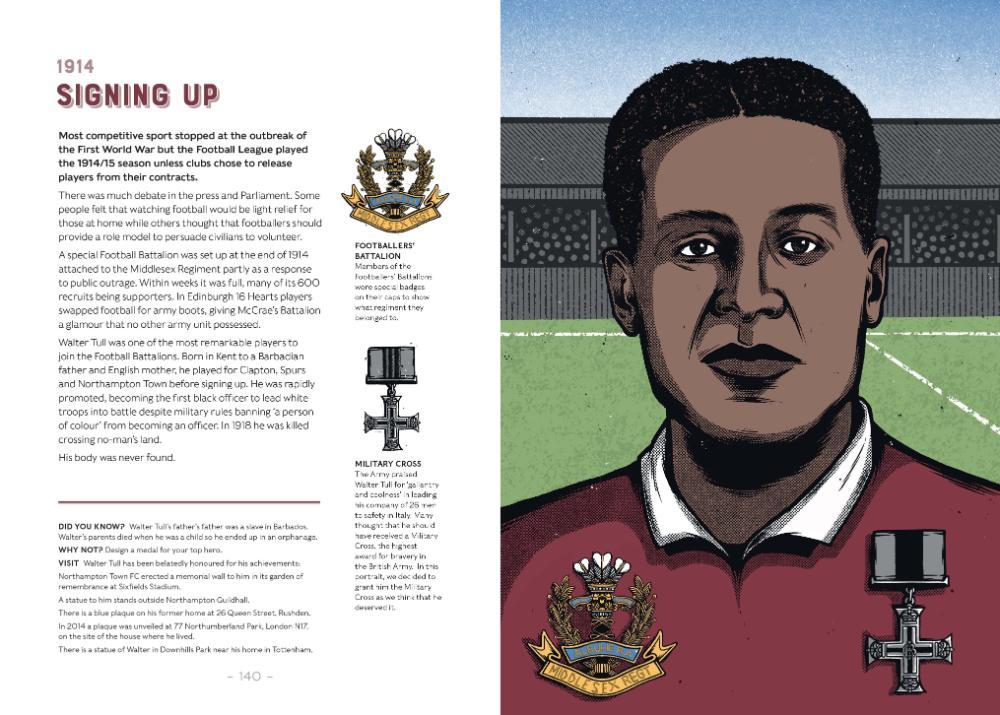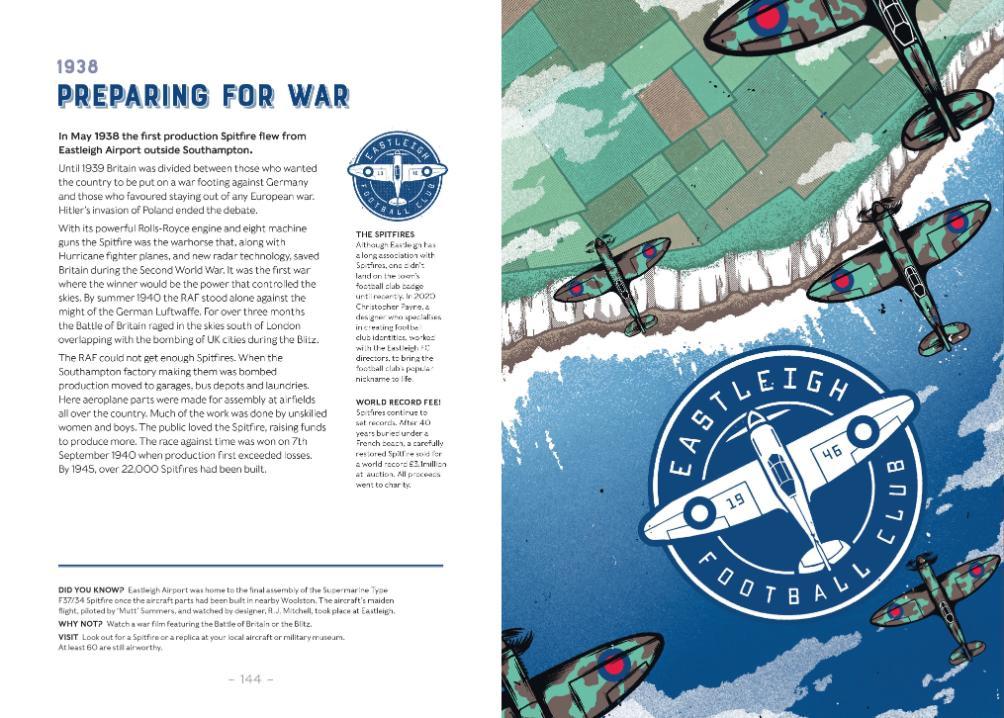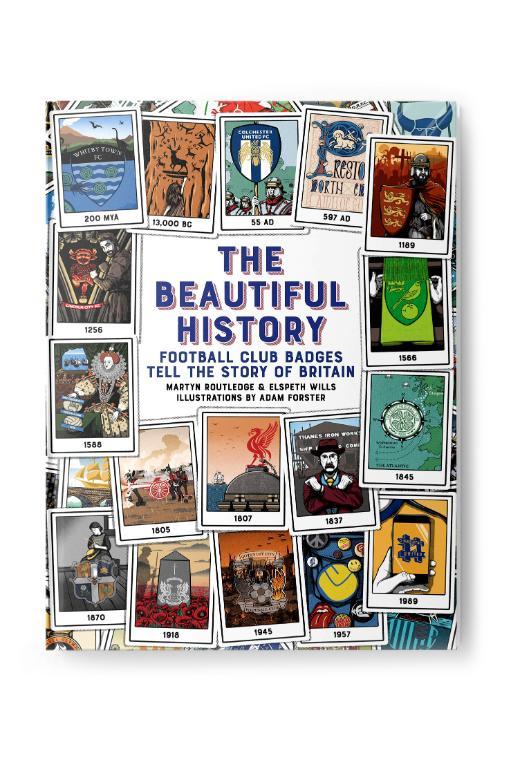Football Badges and 20th Century Conflicts
27/10/2021 - 1.40
Martyn Routledge and Elspeth Wills
Football badges have often featured war or warlike symbols from Arsenal’s cannon to rival Spurs’ cock celebrating one of the most famous medieval fighters, Percy Hotspur. They have also reflected on or commemorated incidents within the two World Wars. Some of the stories of how football joined the fray are well known like Heart of Midlothian, the Dick Kerr Ladies or Leyton Orient: others less so.
Successor to our award-winning The Beautiful Badge, published by Pitch Publishing in 2018, The Beautiful History takes the same theme of football badges but this time uses them to explain and illustrate key dates in British history from the Romans arriving in Britain in 55BC to 1989 and the creation of the world wide web, marked by a team, Hashtag United, which went from virtual to real. Although the aim of the book is to teach football-daft kids a bit of history, the title has also proved popular with adult readers.
The research team dug deep to find references to the key dates in British history. From non-league teams to Premier League giants, it features over 100 clubs whose link with historic dates is visually enriched by the work of young illustrator Adam Forster.

Obviously key dates in the two World Wars are a vital element of the modern story. This section of the book is introduced by the quotation from Sir Arthur Conan Doyle, creator of Sherlock Holmes and fierce opponent of football continuing in wartime, ’If a footballer has strength of limb, let them march and serve in battle.’ We chose 1914 and signing up, picking up the personal story of Walter Tull, the first black officer in the British Army. We featured him wearing the special badge of one of the Football Battalions and tongue in cheek awarded him a much deserved Military Cross for his bravery despite his being denied one in real life as military rules barred persons of colour from becoming officers.

Tull was killed crossing no-man’s land in 1918, the year that saw Britain count up the final tally of four years of conflict. We chose the present badge of Leyton Orient alongside a special badge designed by the supporters’ club, Both badges featured on the supporters’ memorial to the players lost during the Battle of the Somme, close to the memorial site. To mark the run-up to the Second World War, we selected the badge of Eastleigh FC with its Spitfire illustrated by a group of planes returning from a raid, over the Channel. In 1938, the first production Spitfire flew from Eastleigh airport outside Southampton. At the height of the Battle of Britain, parts for Spitfires were produced in garages, workshops and factories throughout Southampton.

To make the point that the Second World War was the first involving civilians in all aspects of their lives from bombing to rationing, we chose Coventry City FC whose badge features a heraldic phoenix marking the recovery of the city after one of the worst bombings of the War. Phoenixes are quite a common symbol in football badges but they usually signal the emergence of a new team from the ashes of a team which has folded. The air raid on the night of 14th November 1940, was the single most concentrated attack on a British city. The raid lasted 11 hours and involved nearly 500 German bombers. The aim was to knock out Coventry as a centre for war production and to avenge a British attack on Munich. During the war many football grounds experienced serious bomb damage, including Stirling’s King’s Park FC’s Forthbank stadium, that was so badly destroyed by bombing, that it had to be demolished and the football club closed for good shortly afterwards to be replaced by Stirling Albion.

One story which failed to pass the final cut of verification but which we loved was that of minnow Fraserburgh FC, the team of the fishing town in the North East of Scotland, their strip and badge are black and white. The story goes that during World War II, their team’s strip was getting very worn but they lacked enough clothing coupons to pay for a new one. One of their team had a friend who played for Newcastle United who parcelled up some of their old strips to send to the club. Hence the Magpies flew North!
Biographical Information
The information in this blog is taken from The Beautiful History: Football Club Badges Tell the Story of Britain, published by Pitch Publishing, whose authors Martyn Routledge and Elspeth Wills, rummaged; through the kitbag of history to make the links between football badges and key events in British history. Can you make the connection between Queen Elizabeth I and Birmingham City FC?
Since it was published in August 2021, The Beautiful History has made it to the Amazon best seller list, has been featured in numerous design and sports magazines and the authors have appeared on ITV, BBC Radio and various podcasts.
Martyn Routledge, runs his own design agency (www.mrcreativestudio.co.uk) working with heritage organisations such as Tower Bridge, as well as sports and leisure brands.
Elspeth Wills is an author and historian: as her day job she interprets history for the general public.



/prod01/wlvacuk/media/departments/digital-content-and-communications/images-2024/240328-Varsity-Line-Up-Resized.jpg)
/prod01/wlvacuk/media/departments/digital-content-and-communications/images-18-19/220325-Engineers_teach_thumbail.jpg)
/prod01/wlvacuk/media/departments/digital-content-and-communications/images-18-19/240509-Find-the-Captain-Pencil-Drawing-Resized.jpg)
/prod01/wlvacuk/media/departments/digital-content-and-communications/images-2024/240320-Uzbekistan-Resized.jpg)
/prod01/wlvacuk/media/departments/digital-content-and-communications/images-2024/240229-The-Link-Resized.jpg)